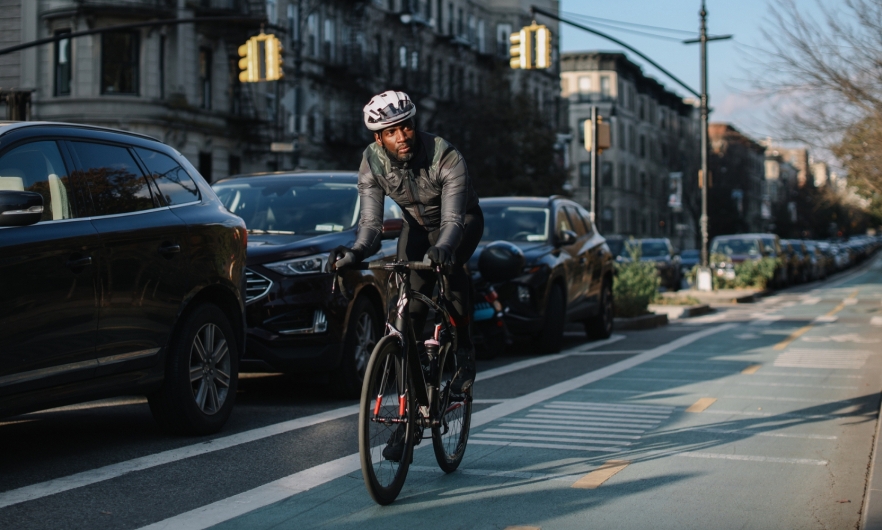How Narrower Traffic Lanes Could Help Reduce Crashes
Narrower streets with room for bike lanes and sidewalks could pay dividends for health and safety.

Why are there so many deadly car crashes in the U.S.? One reason appears to be modern street design—specifically, the oversized travel lanes we see on many American roads.
In this Q&A, adapted from the November 1 episode of Public Health On Call, Shima Hamidi, PhD, MSc, an assistant professor in the Department of Environmental Health and Engineering, discusses a new report from the Bloomberg American Health Initiative that explores how something that was meant to make driving easier could be making it more dangerous, and what can be done to make streets safer and more environmentally friendly at the same time.
Tell us about your report, “A National Investigation on the Impacts of Lane Width on Traffic Safety”.
We are testing this hypothesis that wider lanes and streets are safer. Can we narrow lanes to make more room for pedestrians and cyclists? And really, what are the best ways of using our existing space within the transportation network?
Why do people think wide lanes are safer? Is it because people think you're not going to hit the car next to you?
Streets in the U.S. are designed to facilitate fast and convenient driving. The idea is that since drivers have more room to make mistakes, traffic accidents will be less likely. We wanted to test this.
Because all of these streets are predominantly designed for cars, it's a constant struggle between pedestrians, cyclists, and drivers, and drivers are always the winners. In most of our cities, a very small portion of streets have bike lanes or wide sidewalks.
What did your research find?
We did a national study of more than 1,100 streets from seven cities in the U.S., covering more than 20 street design factors, plus lane weights, and tested the relationship between them and safety indicators like the number of crashes. This is the first national study on lane widths and safety.
What we found was that when you compare 9-, 10-, and 11-foot lanes, there is no difference in the number of crashes. But when you compare 12-foot lanes with 9- and 10-foot lanes, you see that the wider lanes are actually more dangerous. The number of crashes on a street with 12-foot lanes is significantly higher than on streets with narrower lanes. That is the opposite of the general belief and what has been the foundation for street design and lane-width guidelines.
We also looked at differences by speed and found that at lower speeds, 20 to 25 mph, making the lanes wider makes no difference to safety. When you move to 35 mph, wider lanes become significantly more dangerous, with a higher number of crashes. The reason is that wider lanes don't give drivers more room for mistakes, they just make drivers drive faster.
So, one foot really makes a real difference in terms of safety.
One or two feet is the difference between a street having a bike lane or not. If you think of a street with four lanes, and you think of one to one-and-a-half feet of lane width reduction [per lane], that's the space you need to create a bike lane. Or for streets that don't have a sidewalk, that's exactly the space that you need to make a wider sidewalk.
Within existing street infrastructure, that difference is how you're going to accommodate bicyclists and pedestrians in the street without sacrificing safety—and, in most cases, actually improve safety.
If there’s a bike lane, are people more careful about how fast they drive?
Drivers are less concerned about the speed limit and more concerned about the context of the street in determining their driving speed. In other words, on streets that are busier, have trees, lots of pedestrians, a bike lane, and bikes on the street, drivers feel less safe driving fast and will drive slower, regardless of the speed limit. And that's where you also see lane widths playing a role. There’s definitely room to make streets narrower without sacrificing safety.
What is the goal of this research? Are you hoping that lanes will be built narrower, or that current wide lane roads will be retrofitted?
I think both. In many cities, we have lanes that are way wider than what they should be. Guidelines from The American Association of State Highway and Transportation Officials recommend a minimum lane width of 12 feet for high-speed and high-volume roadways and a minimum of 10 to 11 feet for urban areas with heavy pedestrian activity. In Europe, the minimum standard is seven to eight feet. That’s how much room there is to narrow.
Our report proposes which street types are the most immediate candidates for lane width reduction projects. We also include recommendations for revising lane widths and street design guidelines standards. For example, for low-speed streets, instead of starting with 11 feet and having design and traffic engineers justify why it should be narrower, we recommend that cities and state departments of transportation start with 10 feet and have their engineers justify why it needs to be wider. In most cases, it shouldn't be.
This really highlights a link between public health and the built environment. Can you explain more about public health ramifications of street design and lane width?
Narrower lanes will add up to benefits in terms of climate change, environment, public health, and transportation. Traffic fatalities are the leading cause of deaths in the U.S. for people ages 1 to 54. The U.S. also has one of the highest traffic fatality rates among developed countries: 11.6 deaths per 100,000 people in the U.S., versus 1.3 to 3.2 in European countries.
A big reason is the difference in cycling and pedestrian infrastructure; we don't have good sidewalks or bike lanes in the U.S. Adding infrastructure for pedestrians and cyclists will help them use streets for these activities, which would allow more physical activity and reduce the likelihood of obesity and other chronic diseases. The COVID-19 pandemic provided proof of this. When cities closed many streets to cars and made them pedestrian-friendly, we saw thousands of pedestrians use that space. We can use that model in American cities, even after the pandemic.
There are also climate change and environmental impacts. Narrower lanes and streets mean less impervious surface and more cost-efficient, eco-friendly built environments.
Do you think it will be hard to convince people that this is the way to go? In America, bigger is better, right?
Of course. We've talked with several state departments of transportation and they worry: “What if we make streets narrower, and there is a liability of increased accidents?” This study provides national evidence that wider is not safer and in most cases is more dangerous. We hope this report will help departments of transportation make more data-informed decisions about what is the optimal lane width for their cities.
Stephanie Desmon is the co-host of the Public Health On Call podcast. She is the director of public relations and communications for the Johns Hopkins Center for Communication Programs, the largest center at the Johns Hopkins Bloomberg School of Public Health.





